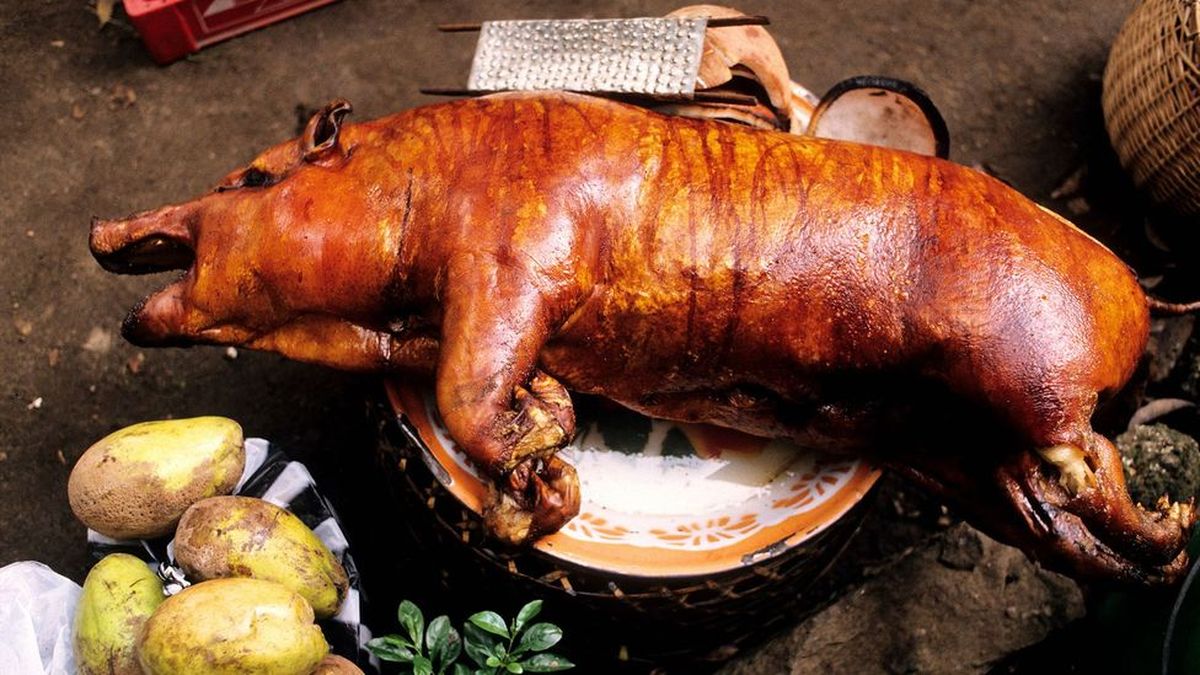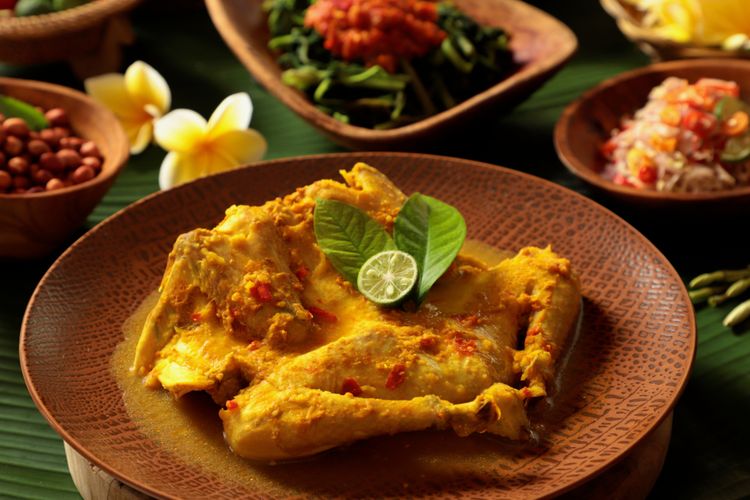Nestled within the Indonesian archipelago, Bali stands as a beacon of cultural and culinary diversity. Renowned as the "Island of the Gods," Bali offers a captivating blend of spirituality, picturesque landscapes, and a unique gastronomic heritage. Unlike other Indonesian provinces predominantly adhering to Islam or Christianity, Bali boasts a distinctive character with the majority of its population embracing Hinduism. This religious foundation weaves through the very fabric of Balinese society, infusing its culinary traditions with depth and symbolism. Embarking on a culinary journey in Bali is an exploration of not only flavors but also a deep-rooted cultural tapestry.
- Bé Guling (ᬩᬾᬕᬸᬮᬶᬂ): An Ode to Tradition and Flavor

Nestled at the heart of Bali's culinary riches is the cherished "Bé Guling," commonly referred to as "Babi Guling," which translates to roast suckling pig. This culinary wonder has surpassed its original purpose, securing a spot as an Indonesian Intangible Cultural Heritage since 2011. Once reserved for sacred ceremonies, Bé Guling has morphed into a culinary sensation cherished by both locals and tourists. The meticulous preparation involves seasoning the pig inside and out before roasting it over open flames.
Served alongside "Basa Gede," a distinctive Balinese spice blend comprising ingredients like shallots, garlic, ginger, and more, Bé Guling holds deep symbolism. The pig's mouth, used for offerings, is filled with banana leaves, while the anus is filled with rice—a representation of simplicity leading to usefulness. The pig's belly is tied, its neck adorned with "janur" leaves and two coins symbolizing sincerity and willingness.
Historically, Bé Guling feasts were part of significant rituals like weddings, funerals, or celebrations for three-month-old infants. This dish symbolizes seeking blessings, inviting prosperity, and expressing gratitude to the divine. Bé Guling embodies Bali's traditions and flavors, a delicious tale woven with cultural significance.
- Lawar (ᬮᬯᬃ): A Balancing Act of Flavors and Tradition

A distinctive aspect of Balinese cuisine, "Lawar" is a harmonious blend of minced meat and vegetables, seasoned with a symphony of spices. Rooted in tradition, Lawar signifies the union of flavors and community. This dish involves combining boiled minced meat with an assortment of vegetables and a medley of spices. The inclusion of unique ingredients like jackfruit and pig's blood highlights the intricate culinary mosaic that is Lawar.
- Betutu (ᬩᭂᬢᬸᬢᬸ): A Slow Dance of Aromas and Heritage

"Betutu" stands as a testament to Bali's culinary finesse. This dish is an embodiment of the island's time-honored techniques and meticulous craftsmanship. Betutu involves slow-cooking a whole chicken or duck after it has been infused with a complex blend of spices. These spices, ranging from shallots to turmeric, ginger, and more, create a sensory masterpiece. Originally a ceremonial delight, Betutu has transcended its ritualistic origins to grace the tables of restaurants and homes, captivating palates with its rich heritage.
- Sate Lilit (ᬲᬢᬾᬮᬶᬮᬶᬢ᭄): A Culinary Allegory of Unity

"Sate Lilit," a unique variation of satay, encapsulates not only flavors but also cultural symbolism. Minced meat, blended with grated coconut and an array of spices, is skewered onto wide, flat sticks before being grilled. The distinct skewer shape symbolizes Bali's unity, reflecting the cohesive spirit of the community. Traditionally reserved for men to prepare, Sate Lilit carries a legacy of masculinity. This dish, which was once part of religious ceremonies, has found a place in Bali's vibrant culinary landscape.
- Nasi Campur Bali (ᬦᬲᬶᬘᬫ᭄ᬧᬸᬃᬩᬮᬶ): A Symphony of Flavors

"Nasi Campur Bali," or Balinese mixed rice, is a culinary masterpiece that epitomizes the fusion of tastes and textures. This dish, served with an array of side dishes and Balinese spice blends, offers a tantalizing exploration of flavors. Basa Genep, the cornerstone of many Balinese dishes, imparts a unique essence to Nasi Campur Bali. With its diverse assortment of side dishes, this dish encapsulates the essence of Bali's culinary philosophy.
- Tipat Cantok (ᬢᬶᬧᬢ᭄ᬘᬦ᭄ᬢᭀᬓ᭄): The Wholesome Bali Delight that Satisfies All

"Tipat Cantok" is a culinary treasure that captures Bali's essence in a single dish. Combining rice cakes, vegetables, and a delectable peanut sauce, it marries taste with tradition. As a popular street food, Tipat Cantok is savored by locals and tourists alike. This vegan delight has not only become a culinary icon but also contributes to the growth of Bali's tourism and economy.
- Nasi Jinggo (ᬦᬲᬶᬚᬾᬂᬕᭀ): A Symphony of Flavor in a Banana Leaf

"Nasi Jinggo" epitomizes Bali's culinary finesse, seamlessly blending convenience and flavor. Wrapped in banana leaves, this culinary gem offers a compact serving of rice alongside an array of mouthwatering side dishes and a tantalizing chili sauce. It captures Bali's inventive spirit, delivering a spectrum of flavors in a single, accessible package.
Originating in the 1980s on Denpasar's Jalan Gajah Mada, Nasi Jinggo's roots are intertwined with the bustling Kumbasari Market. Operating 24/7, this market catered to night owls seeking a satisfying snack. Introduced by an enterprising couple during the late afternoon to evening hours, Nasi Jinggo's novelty swiftly gained popularity. This success led to its expansion, with Nasi Jinggo stalls popping up not only in Denpasar but also in various cities across Bali.
Embarking on a culinary voyage in Bali is a journey into its heart and soul. Each dish tells a story of tradition, unity, and craftsmanship. As you savor the flavors that have been passed down through generations, you're not just indulging in food; you're savoring the very essence of Bali itself. In a world of ever-changing trends, Bali's culinary treasures remain a testament to the timelessness of its culture and the enduring magic of its flavors.
References:
- Putri, Ida Ayu Trisna Eka, et al. “Pengembangan Makanan Khas Bali Sebagai Wisata Kuliner (Culinary Tourism) Di Desa Sebatu Kecamatan Tegalalang Gianyar.” Jurnal Udayana Mengabdi, vol. 12, no. 1, Universitas Udayana, Sept. 2013, ojs.unud.ac.id/index.php/jum/article/view/6405/4926.
- “Ayam Betutu, Sajian Ritual Hingga Jadi Hidangan Ikonik Bali.” CNN Indonesia, 17 Apr. 2020, www.cnnindonesia.com/gaya-hidup/20200417163338-262-494615/ayam-betutu-sajian-ritual-hingga-jadi-hidangan-ikonik-bali.
- O’Gilvie, Diana. “Learning Bali&Rsquo;S True Flavors.” The Jakarta Post, 14 Oct. 2012, www.thejakartapost.com/news/2012/10/14/learning-bali-s-true-flavors.html.
- “Sejarah Dan Filosofi Sate Lilit, Simbol Kejantanan Kaum Pria Bali.” Detikbali, 24 July 2022, www.detik.com/bali/kuliner/d-6196019/sejarah-dan-filosofi-sate-lilit-simbol-kejantanan-kaum-pria-bali.
- “Ciri Khas Makanan Bali Yang Membuatnya Terkenal.” Bobobox, 31 May 2023, bobobox.com/blog/ciri-khas-makanan-bali.
- Dana, Dewa Gede Kumara. “5 Rekomendasi Nasi Campur Terpopuler Di Bali.” Detikbali, 25 May 2023, www.detik.com/bali/kuliner/d-6738434/5-rekomendasi-nasi-campur-terpopuler-di-bali.
- “Tipat Cantok, Sajian Ketupat Ala Bali.” merdeka.com, 7 Dec. 2012, www.merdeka.com/gaya/tipat-cantok-sajian-ketupat-ala-bali.html.
- “Mengenal Hidangan Klasik Bali, Babi Guling.” BBC News Indonesia, 1 Dec. 2015, www.bbc.com/indonesia/vert_tra/2015/12/151130_vert_tra_babiguling.
- Sandi, Eviera Paramita. “Sejarah Dan Makna Penyajian Babi Guling Di Bali.” suara.com, 9 Aug. 2023, bali.suara.com/read/2023/08/09/183000/sejarah-dan-makna-penyajian-babi-guling-di-bali.



















